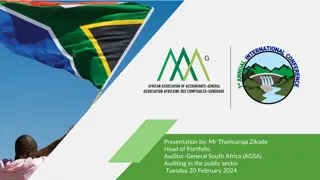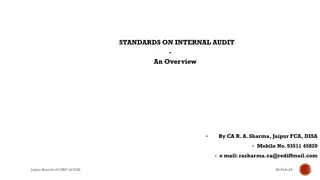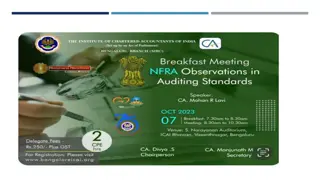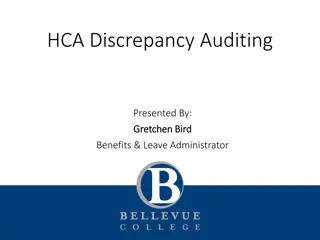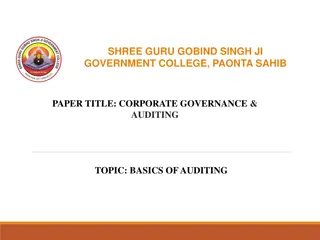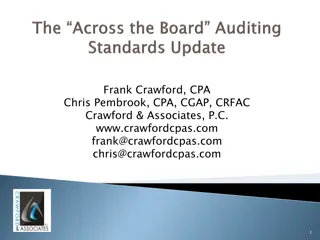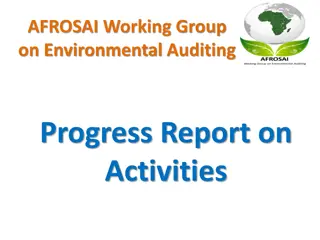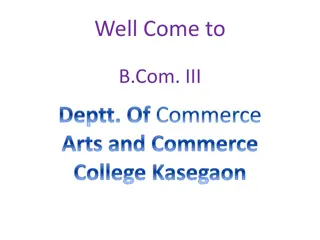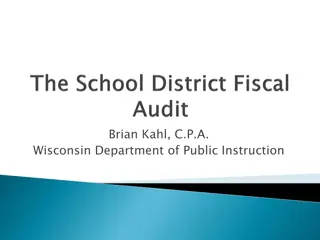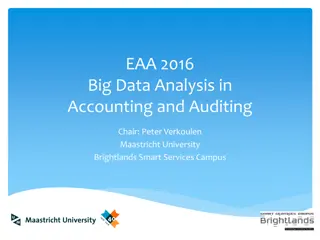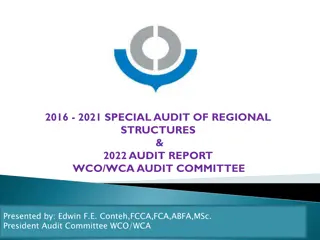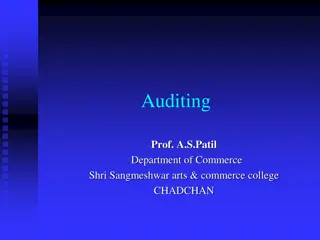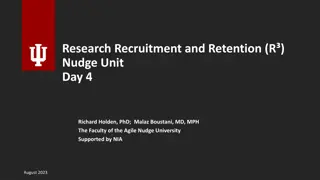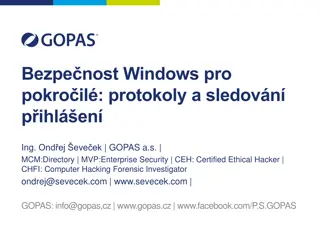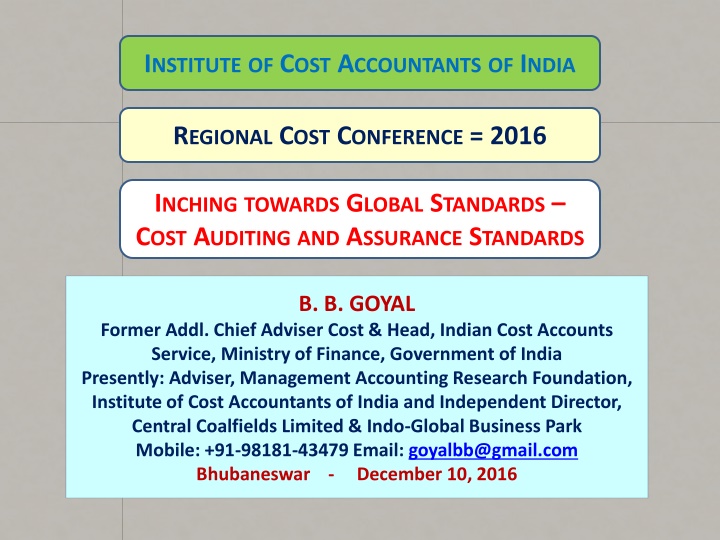
Regional Cost Conference 2016: Inching Towards Global Standards in Cost Auditing and Assurance
Cost Accounting Standards and Cost Auditing Standards play a crucial role in ensuring transparency and accuracy in cost reporting for companies. Learn about the guidelines and procedures set by the Institute of Cost Accountants of India to maintain consistency and completeness in cost records.
Download Presentation

Please find below an Image/Link to download the presentation.
The content on the website is provided AS IS for your information and personal use only. It may not be sold, licensed, or shared on other websites without obtaining consent from the author. If you encounter any issues during the download, it is possible that the publisher has removed the file from their server.
You are allowed to download the files provided on this website for personal or commercial use, subject to the condition that they are used lawfully. All files are the property of their respective owners.
The content on the website is provided AS IS for your information and personal use only. It may not be sold, licensed, or shared on other websites without obtaining consent from the author.
E N D
Presentation Transcript
INSTITUTEOF COST ACCOUNTANTSOF INDIA REGIONAL COST CONFERENCE = 2016 INCHINGTOWARDS GLOBAL STANDARDS COST AUDITINGAND ASSURANCE STANDARDS B. B. GOYAL Former Addl. Chief Adviser Cost & Head, Indian Cost Accounts Service, Ministry of Finance, Government of India Presently: Adviser, Management Accounting Research Foundation, Institute of Cost Accountants of India and Independent Director, Central Coalfields Limited & Indo-Global Business Park Mobile: +91-98181-43479 Email: goyalbb@gmail.com Bhubaneswar - December 10, 2016
Cost Accounting Standards [CAS] Cost Accounting is process of identification, classification, measurement, and assignment of costs to various cost objects. Preparation & Presentation of cost records and cost statements is the responsibility of the Management Therefore, Cost Accounting standards are guidelines for the companies [for the management] that specify the cost accounting treatment for various cost elements, minimum disclosure requirements, and ensure the comparability, consistency, and completeness of cost records. Institute has issued 24 Cost Accounting Standards Has so far issued Guidance Notes on 9 Standards Has also issued Guidance Notes on various other related topics
Standards on Cost Auditing [SCA] Cost Audit is an independent examination of cost statements, cost records and other related information of an entity, with a view to express an opinion thereon. Standards on Cost Auditing provide following guidance to the cost auditor through each step of the audit process. Audit procedures to be followed; Responsibilities of the cost auditor; and Cost reporting. Institute has issued 4 Standards on Cost Auditing that has approval of Government of India Another 15 Standards are awaiting approval of MCA Cost Accountants make mistakes, the Cost Auditors find them
There would be substantial changes in the Cost Accounting Standards and Generally Accepted Cost Accounting Principles after IndAS have come into force with effect from 01.04.2016 There would also be changes in the Presentation of Cost Statements and Formats of Annexure to the Cost Audit Report owing to the changes in Financial Statements as per Schedule- III of the Companies Act, 2013 and also with the implementation of GST in the country But there would be no change in the Standards on Cost Auditing
Standards on Cost Auditing
How Standards are formulated? Standards are issued by the Cost Audit & Assurance Standards Board under the authority of the Council of the Institute of Cost Accountants of India. As per Section 148(3) of the Companies Act 2013, the auditor conducting the cost audit is required to comply with the cost auditing standards . While formulating Standards, CAASB takes into consideration the applicable laws, usage and business environment prevailing in India, relevant provisions of Cost and Works Accountants Act, Rules and Regulations, Code of Professional Ethics, Cost Accounting Standards and other Statements issued by the Institute.
Composition of the Board Six members of the Council of the Institute Head, Cost Audit Branch, MCA One member nominated by the C&AG Two members nominated by Regulatory bodies Two eminent members of the Institute in public practice Two members representing Industry Two members representing Professional Institutes Note: The Chairman is nominated by the Council of the Institute
Types of documents issued by the CAASB: Standards on Quality Control Standards on Auditing Standards on Review Assignments Standards on Assurance Assignments Standards on Related Services Guidance Notes Technical Guides Practice Manuals Note: If a particular Standard or any part thereof is inconsistent with any law in force, the provisions of the said law prevails.
Structure of the Standard Each Standard generally follows the following structure prescribed by the IAASB of IFAC. Introduction Objectives Scope Definitions Requirements Application and other explanatory material Effective date Statement of modification
Procedure Followed Identification of areas Study Group develops preliminary draft Preliminary draft with inputs from Technical Directorate is considered by the Board If approved, issued as Exposure Draft seeking comments of all Stakeholders If not approved; sent to study group for revision ED is hosted on the website of the Institute and published in Management Accountant ED is widely circulated to Regions, Chapters, PPs, Regulatory bodies, Government departments, Professional Institutes, Industry Associations ED exposed for a minimum period of 30 days
Procedure Followed All Comments/Suggestions received alongwith inputs from the Technical Directorate are discussed in the Board Each suggestion is either accepted or rejected with reasons recorded Draft is modified based on the comments/suggestions by stakeholders If substantially modified, again exposed; else approved and sent to Council After approval by the Council, SCA is sent to the MCA All Standards are again examined by the Committee constituted by MCA After MCA approval, issued by the Council for compliance by the members
Standards on Cost Auditing already approved by the Government of India under section 148 of the Companies Act, 2013 and became effective for audit on or after 11.09.2015 CAS-101 - Planning an Audit of Cost Statement CAS-102 - Cost Audit Documentation CAS-103 - Overall Objectives of the Independent Cost Auditor and the Conduct of an Audit in Accordance with Standards on Auditing CAS-104 - Knowledge of Business, its Processes and Business Environment
Standards on Cost Auditing approved by the Council of the Institute and awaiting approval of Government of India SCA-105 - Agreeing the Terms of Cost Audit Engagements SCA-106 - Audit Sampling SCA-107 - Audit Evidence SCA-108 - Materiality in Planning and Performing Cost Audit SCA-109 - Cost Auditor s Responsibility Relating to Fraud in an Audit of Cost Statements SCA-110 - Written Representations SCA-111 - Evaluation of Misstatements identified during the Cost Audit
Standards on Cost Auditing approved by the Council of the Institute and awaiting approval of Government of India SCA-112 - Analytical Procedures SCA-113 - Using the Work of Internal Auditors SCA-114 - Using the Work of Cost Auditor s Expert SCA-115 - Communication with Those Charged with Governance SCA-116 - Communicating Deficiencies in Internal Control to Those Charged with Governance and Management SCA-117 - Identifying and Assessing the Risks of Material Misstatements SCA-118 - The Cost Auditor s Response to the Assessed Risk SCA-119 - Related Parties
Comparison with Global Auditing Standards Sno. IAASB 1 ICAI-CMA CAS-101, Planning an Audit of Cost Statement ISA 300, Planning an Audit of Financial Statements 2 ISA 230, Audit Documentation CAS-102, Cost Audit Documentation 3 ISA 200, Overall Objectives of the Independent Auditor and the Conduct of an Audit in Accordance with International Standards on Auditing CAS-103, Overall Objectives of the Independent Cost Auditor and the Conduct of an Audit in Accordance with Standards on Auditing 4 ISA 315, Identifying and Assessing the Risks of Material Misstatement through Understanding the Entity and Its Environment CAS-104, Knowledge of Business, its Processes and Business Environment SCA-117, Identifying and Assessing the Risks of Material Misstatements 5 ISA 210, Agreeing the Terms of Audit Engagements SCA-105, Agreeing the Terms of Cost Audit Engagements 6 ISA 530, Audit Sampling SCA-106, Audit Sampling
Comparison with Global Auditing Standards Sno. IAASB 7 ICAI-CMA SCA-107, Audit Evidence ISA 500, Audit Evidence ISA 501, Audit Evidence-Specific Considerations for Selected Items 8 ISA 320, Materiality in Planning and Performing an Audit SCA-108, Materiality in Planning and Performing Cost Audit 9 ISA 240, The Auditor's Responsibilities Relating to Fraud in an Audit of Financial Statements SCA-109, Cost Auditor s Responsibility Relating to Fraud in an Audit of Cost Statements 10 ISA 580, Written Representations SCA-110, Written Representations 11 ISA 450, Evaluation of Misstatements Identified during the Audit SCA-111, Evaluation of Misstatements identified during the Cost Audit 12 ISA 520, Analytical Procedures SCA-112, Analytical Procedures
Comparison with Global Auditing Standards Sno. IAASB 13 ICAI-CMA SCA-113, Using the Work of Internal Auditors ISA 610, Using the Work of Internal Auditors 14 ISA 620, Using the Work of an Auditor's Expert SCA-114, Using the Work of Cost Auditor s Expert 15 ISA 260, Communication with Those Charged with Governance SCA-115, Communication with Those Charged with Governance 16 ISA 265, Communicating Deficiencies in Internal Control to Those Charged with Governance and Management SCA-116, Communicating Deficiencies in Internal Control to Those Charged with Governance and Management 17 ISA 330, The Auditor's Responses to Assessed Risks SCA-118, The Cost Auditor s Response to the Assessed Risk 18 ISA 550, Related Parties SCA-119, Related Parties
BESTWAYTOLEARNTHE STANDARDSON COST AUDITING
Understanding SCAs a traditional way Understand the requirements of each Standard. First, read the Glossary of Terms used in the Standards. Then carefully read each word and sentence of the Standard. Initially, the user may feel that the language of the Standards is difficult but reading again and again will help in properly understanding the Standard. Also ask your audit team to read, read, read, and read the Standards So the traditional way of learning the Standards is to read, read, read, and read Not the correct way of understanding the Standards
What you do when you undertake any audit Stage-I Steps Objectives of Audit and Management Outlook [SCA 103] Stage-II Steps Pre-conditions [SCA 105] Stage-III Steps Understanding the Company's Business [SCA 104] Stage-IV Steps Understanding the Company's Structure and Systems followed Stage-V Steps Planning the Audit [SCA 101] Stage-VI Steps Execution of Audit Stage-VII Steps Audit Documentation [SCA 102]
Stage-I Steps Objectives of Audit and Management Outlook [SCA 103] Is the audit only for meeting with the statutory requirements Apart from statutory compliance, do the management have any other expectations or outcomes in its mind such as cost optimization or cost reduction checking parameters of operational efficiency of a unit or any utility or any other function or department captive power generation marketing cost suggesting product diversification or changed product-mix profit makers or loss making products suggesting changed marketing strategies; market expansion; market diversification cost of expanding in other markets, locally or globally complete review of business strategies
Stage-II Steps Pre-conditions Understand the Objectives of cost audit Your area, nature and scope of audit Number of cost auditors appointed The applicable reporting framework The reporting period The statutory deadlines Do the Management understand its scope of work and responsibilities You also decide the audit fee and payment schedule And finally, you get an engagement letter All these are called pre-conditions of audit
Managements Responsibility For maintenance of cost records & producing them to the cost auditor For preparation & presentation of cost statements & other details as per the applicable reporting framework, and in compliance with the cost accounting standards For selection and consistent application of appropriate cost accounting policies For allowing access to the auditor all information, including books of accounts, vouchers, cost records, other records, documents, and other matters of the company, which are relevant to the preparation of the cost statements To provide additional information that the cost auditor may request from management for the purpose of the cost audit To allow unrestricted access to all those persons within the company from whom the cost auditor feels necessary to obtain the cost audit evidence To give proper management representation to the auditor
Stage-III Steps Understanding the Company's Business [SCA 104] You understand the company, its nature of activities, its size, product profile, unit locations, ownership structure, management structure, organisational structure, marketing set-up, accounting set-up, etc. You also understand the nature of the industry or the sector in which your client company operates You also understand the applicable regulatory framework, financial reporting framework, and cost reporting framework You also understand its production process, product details, joint or by-products, outsourcing, if any,
Stage-IV Steps Understanding the Company's Structure and Systems followed Company related details Details of subsidiaries, associates and joint ventures Key personnel in all departments including in Finance, Accounts, Costing, IT, Administration, Production, Purchase, Sales, etc Purchase policy, sales policy, pricing policy, export/import policy Inventory receipt, storage, issue & pricing policies; physical verification system; inventory management system Related parties and nature of transactions with them Indirect tax structure, as applicable
Stage-IV Steps Understanding the Company's Structure and Systems followed Internal Control Systems followed by the company Internal Audit System, its scope & adequacy of coverage as well as effectiveness Accounting systems & Policies followed by the company Cost Accounting System & Policies followed by the company Company's MIS system, risk identification & management system IT architecture followed for financial accounting and for cost accounting; IT policy, control checks, authorization checks; IT data security policy Previous auditor's report
Stage-V Steps Planning the Audit [SCA 101] Timing [dates] and duration [no. of days] of audit period Your plan to visit the unit(s) Level and number of audit personal to be deployed Supervision and review of work done by the audit team Audit partner to be deployed; his expected days & dates Draw up an overall audit plan and audit strategy this will act as guide to the audit team
Stage-V Steps Planning the Audit [SCA 101] Formulate appropriate audit procedures Decide the materiality levels Decide sampling levels Formulate the Test of controls Formulate the Test of details Draw Substantive procedures to be followed Draw Analytical procedures to be followed Formulate risk assessment strategies & procedures Methodology to measure material misstatements Plan discussions with key personnel of the company Plan discussion with the previous cost auditor, statutory financial auditor, and internal auditor
Key inputs for planning results of preliminary activities as specified above knowledge from previous audits and other engagements with the company knowledge of business nature and scope of the audit statutory deadlines and reporting format relevant factors determining the direction of the audit efforts nature, timing and extent of resources required for the audit Document the Audit Plan and share it with the company Ensure adherence to the Guidance Manual for Audit Quality
Stage-VI Steps Execution of Audit Perform the audit checks and procedures, as planned Collect all required audit evidence enabling the auditor to form his opinion validate their relevance and reliability check their accuracy, completeness and sufficiency check the source and consistency Prepare draft observations & discuss with key management personnel Prepare final audit report
Stage-VII Steps Audit Documentation [SCA 102] Document the audit plan, audit program, and audit strategy Document the audit procedures performed Document all working papers Document all the audit evidences obtained Document draft observations and discussions Document final report Preserve all documents in a bound folder/file for the prescribed period The Most Important Step in Audit
Limitations of Audit of Cost Statements Inherent Limitations Use of Professional Judgment Use of Sampling Management Representations Management Assertions Risk of Fraud Time Constraints Independence Threats Scope
Impact of Standards on Cost Auditing
Impact of SCAs They are your best friends, your best guide and your best helpdesk If followed scrupulously, the standards would help you to streamline your audit, to do better planning, better documentation, and effective implementation They will help in improving the overall quality of audit You should carefully go through the standards and make best use of them Please do not use them to frighten your client or a document to extract more money; rather take the client on board; send him a brief of the applicable standards and discuss
Impact of SCAs Use the standards to the extent these are applicable to your nature and scope of audit The Standards authorize you to use the work of another auditor or expert hence don't check every detail again which is already audited by another auditor or is certified by an expert You need not remember the Auditing Standards; but practice them Make them part of your work culture; teach them to your entire team Study the Application Guidance Notes on SCAs Remain fully updated on the new SCAs
Important Terms used in the Standards on Cost Auditing
Management Representation: A written statement by management provided to the cost auditor to confirm certain matters or to support other audit evidence. Written representations in this context do not include financial statements, cost statements, the assertions therein, or supporting books and records. Management Representation relate to number of subjects such as Cost Statements Matters relating to Operations Cost Measurement and Assignment Information & Access Provided Adequacy of Systems A sample of the representation is given in SCA-110
Audit Assertions are the implicit or explicit claims and representations made by the management responsible for the preparation of cost statements regarding the appropriateness of the various elements of cost statements and disclosures. Occurrence - Costs recognized in the cost statements have occurred and relate to the entity. Completeness - All costs that were supposed to be recorded have been recognized in the cost statements. Accuracy - Costs have been recorded accurately at their appropriate amounts. Cut-off - Costs have been recognized in the correct accounting periods. Measurement - Costs have been correctly measured as per the applicable Standards. Classification - Costs have been classified and presented fairly in the cost statements. Presentation & Disclosure - Costs have been correctly disclosed as per the applicable cost reporting framework.
Audit Risk Audit Risk is the risk that the cost auditor expresses an inappropriate audit opinion on the cost statements that are materially misstated. Audit Risk = Inherent Risk x Control Risk x Detection Risk Audit risk is a function of the risk of material misstatement and detection risk. The risk of material misstatement has two components viz. Inherent Risk and Control risk.
Inherent Risk, Control Risk & Detection Risk Inherent Risk is the risk of a material misstatement in the cost statements arising due to error or omission as a result of factors other than the failure of controls. Totaling mistake Mistake to correctly carry the opening balances Failure to account for all expenses relating to the year Wrong assessment of capacity Control Risk is the risk of a material misstatement in the cost statements arising due to absence or failure in the operation of relevant controls of the entity. Failure to perform supervisory or authentication checks Failure to verify the veracity & accuracy of information Failure to control frauds [fake staff bills, fake production, fake sales, fake consumption, Detection Risk is the risk that the auditors fails to detect a material misstatement in the cost statements.
Tentative areas of Misstatements in Cost Statements, either due to error or fraud (A) Understatement or overstatement of installed capacties Misstatement in measurement, classification, allocation, apportionment and absorption of costs Misstatement of costs with a view to claim higher subsidies or evade taxes or due to error Over-valuation or under-valuation of inventory either due to error or with a view to manipulate profits and taxes Wrong consumption of raw materials, utilities and other inputs resulting in misstatement in cost of production Misstatement in production and sales records to evade taxes Wrongful recognition of revenues Wrong classification of joint-products or by-products
Tentative areas of Misstatements in Cost Statements, either due to error or fraud (B) Significant variations in physical inventories vis-a-vis stock statements Non or wrong recognition of idle capacities, idle facilities, idle manpower, etc. Overstatement or understatement of scrap, defectives, wastages, spoilage, etc. Non-recognition of cases of thefts, pilfirage, etc., if any Recognition of abnormal costs as normal costs or vice versa Recognition of non-cost items as costs or vice versa Inappropriate traceability of costs to particular cost objects Misstatement in arm s length price in relation to transactions with related parties Wrong certification of stocks lying with third parties
Tentative areas of Misstatements in Cost Statements, either due to error or fraud (C) Over or under invoicing of purchases or sales Recognition of fake bills of purchases of goods and services Recognition of costs not actually incurred Treatment of capital as revenue or vice-versa Booking of fake manpower costs not actually engaged Wrongful recognition of group companies costs or assets Recognition of dead or unserviceable stocks as 'good' inventories or vice versa Recognition of third party stocks as own stocks or vice versa Non-booking of costs already accrued Mistatement in quantities and values showing material mismatch with cost estimates
Tentative areas of Misstatements in Cost Statements, either due to error or fraud (D) Treatment of self-manufactured materials, components, sub-assemblies, tools, etc. as purchases Valuation of international transactions at wrong forex rates Wrongful recognition of subsidies, grants, incentives, etc. Recognition of imputed costs Recognition of defectives production as good ones or vice versa Recognition of semi-finished goods as finished goods or vice versa Under or overstating life of assets [or additions to or deletion of assets] resulting in over or undercharging of depreciation or amortization
OTHER IMPORTANT TERMS Audit documentation:Audit Documentation means the records, in physical or electronic form, including working papers prepared by and for, or obtained and retained by the Cost auditor, in connection with the performance of the audit. Management:The person(s) with executive responsibility for the conduct of the entity s operations. Misstatement:A difference between the amounts, classification, presentation or disclosure of a reported cost statement item and the amount, classification, presentation, or disclosure that is required for the item to be in accordance with the applicable cost reporting framework. Misstatements can arise from error or fraud.
OTHER IMPORTANT TERMS Risk Assessment:The audit procedures performed to obtain an understanding of the entity and its environment, including the entity s internal control, to identify and assess the risks of material misstatement, whether due to fraud or error, at the overall cost statement level and at the assertion level including items of cost, cost heads and disclosure thereof. Those charged with governance:The person(s) or organisation(s) (e.g., a corporate trustee) with responsibility for overseeing the strategic direction of the entity and obligations related to the accountability of the entity. This includes overseeing the cost and financial reporting process. Audit Evidence: Information used by the cost auditor in arriving at the conclusions on which the cost auditor s opinion is based. Audit evidence includes both information contained in the cost accounting records underlying the cost statements and all other related information.
OTHER IMPORTANT TERMS Cost Reporting Framework:Cost Reporting Framework means the framework adopted by the management and, where appropriate, by those charged with governance, in the preparation of the cost statements that is acceptable in view of the nature of the entity and the objective of the cost report, or that is required by law or regulation. Performance Materiality:Performance materiality means the amount or amounts set by cost auditor at less than materiality for the cost statements as a whole to reduce to an appropriately low level the probability that the aggregate of uncorrected and undetected misstatement exceeds materiality for the cost statements as whole. Preconditions for cost audit:The use by management of an acceptable cost reporting framework in the preparation of the cost statements and the agreement of management and, where appropriate, those charged with governance to the premise on which cost audit is conducted.

